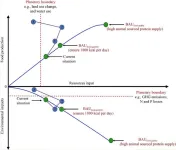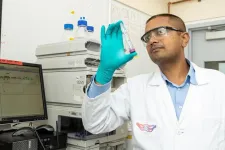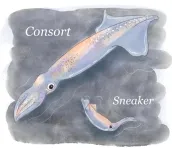Towards sustainable food systems: global initiatives and innovations
2024-04-24
(Press-News.org)
Contemporary food systems were originally developed to tackle challenges of the mid-20th century, aiming to supply abundant, efficient, non-perishable starchy calories to accommodate the expanding global population. Although substantial progress has been made in global food security over the past several decades, there still exist large populations experiencing hunger worldwide. Currently, global hunger primarily refers to insufficient calorie intake. Hidden hunger is the presence of multiple micronutrient in the absence of an energy-deficit diet. Hidden hunger, particularly the inadequate consumption of high-quality protein, has resulted in significant but often unnoticed health consequences. Resolving the hidden hunger for people is the central to meeting the UN SDGs, especially for SDG2. The global food system is at a critical juncture, facing a confluence of challenges and opportunities that demand a profound transformation. Transforming the food system can improve access to nutritious and affordable food for vulnerable populations and enhance global food security.
Prof. Lin Ma from Nanjing University and his team proposed a three-step approach to transform the food system by integrating various novel technologies. The primary task at the current global stage is to address the issue of hunger. The first step should focus on addressing people’s calorie needs, which are essential for achieving the SDG Zero Hunger goal. While addressing calorie requirements, efforts should couple crop and livestock cycles to reduce environmental pollution caused during the food production process. The second step should consider people’s demand for high-quality protein, enabling the transition from simply eating enough to eating well. At this stage, emission reduction technologies should be introduced to reduce environmental pollution during the food production process. The third step is to enhance global food production efficiency and environmental sustainability, ensuring that natural resource consumption and environmental emissions associated with food production remain within planetary boundaries.
In the first step, a potential pathway provided to improve the production of crop system and livestock system. For crop system, based on various limited factors of each country such as soil fertility, arable areas, and irrigation capabilities, a quantitative analysis is conducted to determine the maximum yield potential and efficiency potential of crops in each country. Subsequently, in conjunction with the relevant policy guidelines related to food production in each country, corresponding technical optimization such as seed breeding, field reclamation and better management practice are recommended to increase crop yield. For livestock system, each country should enhance meat production by optimizing feeding structure and high production performance livestock breeds to improve feed conversion rates. In term of environment, coupled crop and livestock system can be recommended for reducing environmental pollution and advancing agricultural green development.
In the second step, reducing regular food consumption and using alterative novel food source have been recognized as efficient strategies for resolving hidden hunger and reducing environmental impacts. Novel foods encompass a wide range of innovations, including insect-based products, algae, aquatic products, and lab-grown meats. The adoption of novel foods can meet the high protein food demand and alleviate the pressure on natural ecosystems.
In the third step, this study proposes optimization global trade and spatial planning techniques to further enhance food production and environmental efficiency, ensuring the achievement of both global SDG goals and AGD objectives. Firstly, this step is to establish classification criteria for various countries around world, including food production efficiency, environmental thresholds and natural resource constraints. Then, countries are categorized globally into high food production efficiency and low food production efficiency based on established classification criteria. Additionally, countries are classified in terms of their environmental impact, distinguishing between high-pollution and low-pollution nations. In the end, it should encourage high food production efficiency counties to maximize food production within the limits of environmental and natural resource thresholds and export to countries with low food production efficiency, thereby enhancing global resource efficiency.
This study can help counties to formulate corresponding policies and actively promote the transformation of the food system to achieve agricultural green and sustainable development.
This study has been published on the Journal of Frontiers of Agricultural Science and Engineering in Volume 11, Issue 1, 2024, DOI: 10.15302/J-FASE-2024544.
END
[Attachments] See images for this press release:

ELSE PRESS RELEASES FROM THIS DATE:
2024-04-24
An international team of researchers, led by Danielle DeLeo from the Smithsonian Institution, has identified eight organisms with previously unknown luminosity. Using genetic findings from these organisms and previous studies, they estimated that coral bioluminescence originated about 540 million years ago in the Cambrian period, making them the earliest bioluminescent organisms. During this period, they shared the oceans with invertebrates with light-sensitive eyes, hinting that interspecies interactions occurred involving light. They published their findings in Proceedings of the Royal Society B.
While shallow-water ...
2024-04-24
SRI announced today that it has been selected by the Defense Advanced Research Projects Agency (DARPA) to deliver advanced technology for its recently launched Multiobjective Engineering and Testing of ALloy Structures (METALS) program.
DARPA METALS aims to break today’s one-material-per-part paradigm, which can lead to vulnerabilities and reduced life when highly engineered components experience austere environments. The goal of the four-year program is to develop technologies that treat material selection – particularly metallic alloys – as a continuous ...
2024-04-24
Vaccines remain the gold standard of protection against dangerous pathogens, but take considerable time and vast resources to develop. Rapidly mutating viruses such as SARS-CoV-2 can blunt their effectiveness and even render them obsolete.
To address these gaps, a multi-university team led by New Jersey Institute of Technology’s Vivek Kumar is developing a hydrogel therapy that acts as a first line of defense against viruses and other biological threats. The peptides that make up this gel prevent viruses ...
2024-04-24
WASHINGTON –Perinatal transmission of HIV to newborns is associated with serious cognitive deficits as children grow older, according to a detailed analysis of 35 studies conducted by Georgetown University Medical Center neuroscientists. The finding helps pinpoint the geographic regions and factors that may be important for brain development outcomes related to perinatal HIV infection: mother-to-child HIV transmission during pregnancy, labor and delivery, or breastfeeding.
The findings appeared in eClinicalMedicine on April 23, 2024.
Mostly because of advances in antiretroviral therapies, AIDS, which is caused by HIV infection, has ...
2024-04-24
In Europe and North America, 30 to 60% of dietary energy intake in adults comes from ultra-processed foods. An increasing number of epidemiological studies suggest a link between higher consumption levels of ultra-processed foods with higher risks of diabetes and other metabolic disorders.
Emulsifiers are among the most commonly used additives. They are often added to processed and packaged foods such as certain industrial cakes, biscuits and desserts, as well as yoghurts, ice creams, chocolate bars, industrial breads, margarines and ready-to-eat or ready-to-heat meals, in order to improve their appearance, taste and texture and lengthen ...
2024-04-24
Imagine being able to look inside a single cancer cell and see how it communicates with its neighbours.
Scientists are celebrating a new technique that lets them study the fatty contents of cancer cells, one by one.
A study led by the University of Surrey has sampled single live cancer cells and measured the fatty lipid compounds inside them. Working with partners at GSK and UCL, and developing new equipment with Yokogawa, the team saw how those cells transformed in response to changes in their environment.
Dr ...
2024-04-24
Bioluminescence first evolved in animals at least 540 million years ago in a group of marine invertebrates called octocorals, according to the results of a new study from scientists with the Smithsonian’s National Museum of Natural History.
The results, published today, April 23, in the Proceedings of the Royal Society B, push back the previous record for the luminous trait’s oldest dated emergence in animals by nearly 300 million years, and could one day help scientists decode why the ability to produce light evolved in the first place.
Bioluminescence—the ability of living things to produce light via chemical reactions—has independently ...
2024-04-24
The day a male spear squid hatches determines which mating tactic he will use throughout his life, according to new research. Spear squid (Heterololigo bleekeri) that hatch earlier in the season become “consorts” which fight for mating opportunities. Those which hatch later become “sneakers,” which use more clandestine mating tactics. Researchers found that the mating tactic determined by the birth date was fixed for the squid’s whole life. Understanding how mating tactics are influenced by birth date, and the environmental conditions at that time, can help researchers consider ...
2024-04-24
Embargoed until 00:01am BST on Wednesday 24 April 2024/19.01pm ET on Tuesday 23 April 2024
-With pictures-
The Universe’s early galaxies were less chaotic and developed much faster than previously thought, according to new research looking back more than ten billion years in time.
An international team of astronomers led by Durham University, UK, used the James Webb Space Telescope (JWST) to find evidence of bar formation when the Universe was only a few billion years old.
Bars are elongated strips of stars found in disc or ...
2024-04-24
RICHLAND, Wash.—There’s some irony in the fact that devices that seem indispensable to modern life—mobile phones, personal computers, and anything battery-powered—depend entirely on minerals extracted from mining, one of the most ancient of human industries. Once their usefulness is spent, we typically return these objects to the Earth in landfills, by the millions.
But what if we could “mine” electronic waste (e-waste), recovering the useful minerals contained within them, instead of throwing them away? A clever method of recovering valuable minerals from e-waste, developed by a research team at the Department ...
LAST 30 PRESS RELEASES:
[Press-News.org] Towards sustainable food systems: global initiatives and innovations






